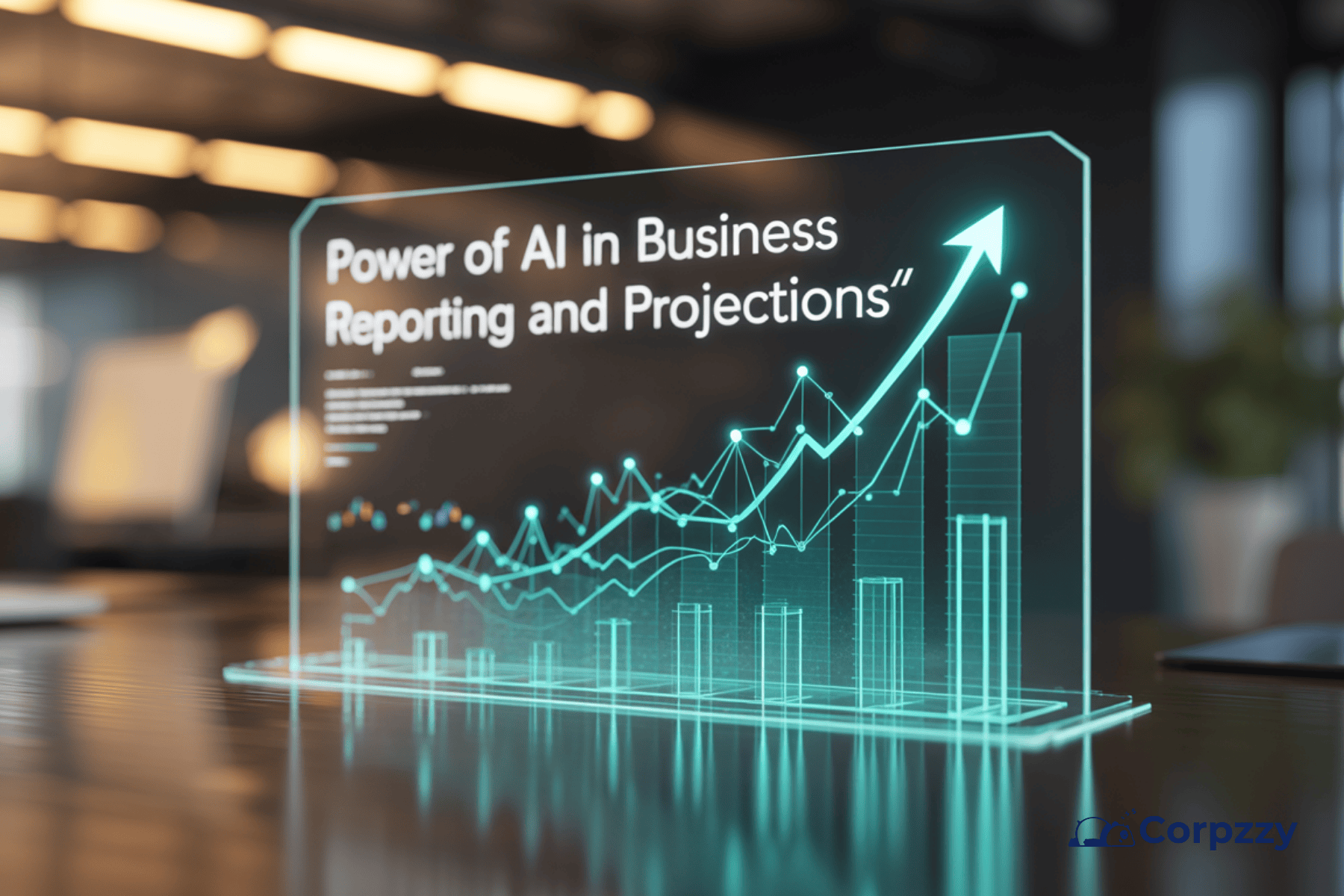AI in Business Reporting & Projections: Power, Pitfalls, and Real-World Wins
AI in Business Reporting & Projections: Power, Pitfalls, and Real-World Wins
Outline

AI is rapidly transforming the way businesses forecast demand, monitor performance, and make strategic decisions. By automating projections and reporting processes, AI empowers companies to plan with greater speed, accuracy, and insight. These tools rely on machine learning models that analyze historical data, identify patterns, and generate predictive outputs. As adoption grows, understanding how AI works and where it adds value is essential for staying competitive in today’s data-driven economy. Organizations that embrace AI in their reporting frameworks can respond faster to market changes, reduce waste, and streamline internal processes. Countries like Malaysia, Singapore, and Indonesia are seeing accelerated interest in AI across sectors like logistics, manufacturing, and finance. While the benefits are clear, proper implementation depends on clean data, stakeholder trust, and continuous monitoring. This article explores how AI-powered forecasting works in theory, current case studies, implementation best practices, and the challenges that businesses must manage.
How AI Forecasting Works in Theory
AI forecasting typically involves training algorithms to recognize patterns in historical and real-time data. These models—ranging from time-series analysis to deep learning—predict outcomes such as sales volumes, stock levels, or revenue based on evolving trends. Unlike traditional spreadsheet methods, AI can factor in external influences like weather, promotions, and market shifts to improve accuracy. Once trained, these models continuously learn from new data, making them adaptable to changing business conditions. Forecasts are generated automatically and can be visualized in dashboards with confidence intervals and explainability features. These insights can be used to plan inventory, staffing, or marketing spend. Advanced models can even simulate “what-if” scenarios, allowing businesses to test the impact of decisions before execution.
Real-World Use: Manufacturing Forecast Accuracy
A global food manufacturer working with C3 AI integrated 18 internal and external data sources to build a demand forecasting system. The AI solution increased forecast accuracy by 8%, while also reducing schedule generation time by 96%, resulting in margin improvements estimated at USD 30 million across their supply chain (C3 AI, 2023). This project was completed in just 16 weeks and demonstrates how quickly AI tools can be deployed when supported by strong data infrastructure. The manufacturer was able to plan production more accurately and reduce stockouts and overages. This not only optimized logistics but also minimized waste—an increasingly critical KPI in sustainability efforts.
Real-World Use: Vaccine Supply Chain Forecasting
In a separate C3 AI case study, a multinational pharmaceutical company deployed AI to forecast vaccine demand across different regions. The AI model improved forecast accuracy by 20% over statistical methods, outperforming traditional manual processes (C3 AI, 2024). As a result, the company reduced inventory costs by over USD 20 million annually, while improving delivery rates in underserved markets. This highlights how AI-driven reporting isn’t just about cost savings—it can also enhance operational resilience and support public health goals. Predictive insights allowed the company to allocate vaccines where they were needed most, in real time.
Real-World Use: Sales Forecasting at Upwork
Upwork’s Revenue Operations (RevOps) team leveraged Gong’s AI revenue intelligence platform to replace manual sales forecasting with automated insights. By analyzing deal-level interactions, Gong helped Upwork achieve 95% forecast accuracy—up from inconsistent historical accuracy rates (Gong, 2023). This transformation eliminated forecasting bias, streamlined internal reporting cycles, and enabled cross-functional teams to align on pipeline performance. AI not only improved forecast precision but also helped sales managers identify risks and coaching opportunities through voice and text analytics. These insights translated into faster decision-making and more reliable quarter-end outcomes.
Key Benefits of AI in Forecasting
AI systems improve forecast accuracy by up to 20%, significantly outperforming traditional spreadsheet models, especially in complex environments with large datasets. This increase in precision reduces waste, minimizes stockouts, and lowers working capital requirements (McKinsey & Company, 2022).
Additionally, AI reduces the time required to generate forecasts—by as much as 80%—freeing analysts to focus on strategy instead of manual data entry. Interactive dashboards and predictive alerts empower leaders to make informed decisions, even in volatile markets. By centralizing data and automating analysis, companies also gain consistency in reporting across departments.
How It Works: From Data to Decision
AI forecasting models rely on structured data, including historical transactions, CRM records, supply chain metrics, and external indicators like macroeconomic trends. Once data is ingested and cleansed, machine learning algorithms extract relevant features, identify patterns, and train prediction models. These predictions are fed into visualization tools like Power BI or Tableau for consumption by non-technical stakeholders.
Real-time model retraining ensures relevance, while explainability modules clarify what drives predictions. Teams can simulate business decisions—like launching a product or adjusting prices—and view projected outcomes instantly. AI bridges the gap between data science and strategic planning, helping businesses take action faster.
Limitations of AI Forecasting
Despite the upside, AI forecasting has notable limitations—chief among them is the need for clean, comprehensive, and unbiased data. Poor data quality can skew results, leading to inaccurate predictions that may harm decision-making (Deloitte, 2023).
Another limitation is the “black box” nature of some models, where it’s difficult for users to understand how the algorithm reached a conclusion. This lack of transparency can erode stakeholder trust and lead to unnecessary overrides. In regulated sectors like banking or healthcare, explainability is not optional—it’s mandatory. Companies must ensure their AI systems meet compliance and auditability standards.
Mitigating Risks and Ensuring ROI
The best practice for mitigating AI risks is to establish strong data governance protocols. This includes data validation, role-based access, and a clear audit trail. Businesses should also start with pilot programs before full-scale deployment to identify issues early and build organizational buy-in.
It’s also essential to integrate explainable AI (XAI) frameworks that help users understand the rationale behind forecasts. Combining AI-generated insights with human oversight ensures that forecasts are not only fast and scalable, but also aligned with business goals. AI should augment, not replace, decision-makers.
Emerging Trends in AI Forecasting
Narrative forecasting—where AI converts data into plain-language summaries—is gaining popularity, especially for executive reporting. These tools can write commentary on forecast changes, explain variances, and even suggest corrective actions (Gartner, 2023).
Another trend is the integration of real-time data feeds, including weather, shipping delays, or even social media sentiment, into forecasting models. This creates more adaptive systems capable of responding to real-world events. Some companies are now exploring autonomous planning systems that not only forecast but also trigger actions—like ordering inventory or adjusting marketing spend automatically.
Is AI the Future of Forecasting?
AI is not a replacement for experienced finance professionals or planners—it’s a force multiplier. When integrated well, it can provide deep insights that improve decision-making, resource allocation, and overall business agility (Harvard Business Review, 2022).
Companies that combine the speed of AI with the judgment of humans will outperform competitors who rely on manual methods. In Southeast Asia, where markets are rapidly evolving and labor costs are rising, AI offers a clear path to scale operations without scaling headcount. However, successful AI forecasting is a journey—not a quick fix.
Conclusion
AI forecasting and reporting tools are helping businesses move from reactive to proactive decision-making. Whether used in sales, manufacturing, or logistics, these systems can generate accurate, timely forecasts while freeing up human capital for strategic tasks. Case studies from global companies like Upwork and C3 AI prove that when implemented correctly, AI leads to measurable gains in accuracy, efficiency, and profitability.
That said, data quality, governance, and trust remain essential pillars for AI success. Organizations must invest in their data infrastructure and balance automation with oversight. The future of business forecasting lies not in replacing humans—but in equipping them with the best tools AI has to offer.
References
- C3 AI. (2023). Case Study: AI for Demand Forecasting. Retrieved from https://c3.ai/wp-content/uploads/2023/04/C3-AI-Case-Study-AI-for-Demand-Forecasting.pdf
- C3 AI. (2024). Case Study: Biopharma Demand Forecasting. Retrieved from https://c3.ai/wp-content/uploads/2024/11/C3AI_Case_Study_Demand_Forecasting-for-Biopharma.pdf
- Gong. (2023). Upwork Achieves 95% Forecast Accuracy Using Gong. Retrieved from https://www.gong.io/case-studies/upworks-revops-team-rockets-to-95-sales-forecast-accuracy-using-gong/
- McKinsey & Company. (2022). The Value of AI in Supply Chain Forecasting. Retrieved from https://www.mckinsey.com/business-functions/operations/our-insights
- Deloitte. (2023). AI Governance and Data Integrity in Finance. Retrieved from https://www2.deloitte.com/us/en/pages/risk/articles/ai-governance.html
- Gartner. (2023). Forecasting with Generative AI: Market Guide. Retrieved from https://www.gartner.com/en/documents
- Harvard Business Review. (2022). AI in Forecasting: Human + Machine Collaboration. Retrieved from https://hbr.org/2022/09/how-ai-is-changing-forecasting
Frequently Asked Questions
Questions? We Have Answers
About The Author
Related Business Articles
Share This Story, Choose Your Platform!


AI is rapidly transforming the way businesses forecast demand, monitor performance, and make strategic decisions. By automating projections and reporting processes, AI empowers companies to plan with greater speed, accuracy, and insight. These tools rely on machine learning models that analyze historical data, identify patterns, and generate predictive outputs. As adoption grows, understanding how AI works and where it adds value is essential for staying competitive in today’s data-driven economy. Organizations that embrace AI in their reporting frameworks can respond faster to market changes, reduce waste, and streamline internal processes. Countries like Malaysia, Singapore, and Indonesia are seeing accelerated interest in AI across sectors like logistics, manufacturing, and finance. While the benefits are clear, proper implementation depends on clean data, stakeholder trust, and continuous monitoring. This article explores how AI-powered forecasting works in theory, current case studies, implementation best practices, and the challenges that businesses must manage.
How AI Forecasting Works in Theory
AI forecasting typically involves training algorithms to recognize patterns in historical and real-time data. These models—ranging from time-series analysis to deep learning—predict outcomes such as sales volumes, stock levels, or revenue based on evolving trends. Unlike traditional spreadsheet methods, AI can factor in external influences like weather, promotions, and market shifts to improve accuracy. Once trained, these models continuously learn from new data, making them adaptable to changing business conditions. Forecasts are generated automatically and can be visualized in dashboards with confidence intervals and explainability features. These insights can be used to plan inventory, staffing, or marketing spend. Advanced models can even simulate “what-if” scenarios, allowing businesses to test the impact of decisions before execution.
Real-World Use: Manufacturing Forecast Accuracy
A global food manufacturer working with C3 AI integrated 18 internal and external data sources to build a demand forecasting system. The AI solution increased forecast accuracy by 8%, while also reducing schedule generation time by 96%, resulting in margin improvements estimated at USD 30 million across their supply chain (C3 AI, 2023). This project was completed in just 16 weeks and demonstrates how quickly AI tools can be deployed when supported by strong data infrastructure. The manufacturer was able to plan production more accurately and reduce stockouts and overages. This not only optimized logistics but also minimized waste—an increasingly critical KPI in sustainability efforts.
Real-World Use: Vaccine Supply Chain Forecasting
In a separate C3 AI case study, a multinational pharmaceutical company deployed AI to forecast vaccine demand across different regions. The AI model improved forecast accuracy by 20% over statistical methods, outperforming traditional manual processes (C3 AI, 2024). As a result, the company reduced inventory costs by over USD 20 million annually, while improving delivery rates in underserved markets. This highlights how AI-driven reporting isn’t just about cost savings—it can also enhance operational resilience and support public health goals. Predictive insights allowed the company to allocate vaccines where they were needed most, in real time.
Real-World Use: Sales Forecasting at Upwork
Upwork’s Revenue Operations (RevOps) team leveraged Gong’s AI revenue intelligence platform to replace manual sales forecasting with automated insights. By analyzing deal-level interactions, Gong helped Upwork achieve 95% forecast accuracy—up from inconsistent historical accuracy rates (Gong, 2023). This transformation eliminated forecasting bias, streamlined internal reporting cycles, and enabled cross-functional teams to align on pipeline performance. AI not only improved forecast precision but also helped sales managers identify risks and coaching opportunities through voice and text analytics. These insights translated into faster decision-making and more reliable quarter-end outcomes.
Key Benefits of AI in Forecasting
AI systems improve forecast accuracy by up to 20%, significantly outperforming traditional spreadsheet models, especially in complex environments with large datasets. This increase in precision reduces waste, minimizes stockouts, and lowers working capital requirements (McKinsey & Company, 2022).
Additionally, AI reduces the time required to generate forecasts—by as much as 80%—freeing analysts to focus on strategy instead of manual data entry. Interactive dashboards and predictive alerts empower leaders to make informed decisions, even in volatile markets. By centralizing data and automating analysis, companies also gain consistency in reporting across departments.
How It Works: From Data to Decision
AI forecasting models rely on structured data, including historical transactions, CRM records, supply chain metrics, and external indicators like macroeconomic trends. Once data is ingested and cleansed, machine learning algorithms extract relevant features, identify patterns, and train prediction models. These predictions are fed into visualization tools like Power BI or Tableau for consumption by non-technical stakeholders.
Real-time model retraining ensures relevance, while explainability modules clarify what drives predictions. Teams can simulate business decisions—like launching a product or adjusting prices—and view projected outcomes instantly. AI bridges the gap between data science and strategic planning, helping businesses take action faster.
Limitations of AI Forecasting
Despite the upside, AI forecasting has notable limitations—chief among them is the need for clean, comprehensive, and unbiased data. Poor data quality can skew results, leading to inaccurate predictions that may harm decision-making (Deloitte, 2023).
Another limitation is the “black box” nature of some models, where it’s difficult for users to understand how the algorithm reached a conclusion. This lack of transparency can erode stakeholder trust and lead to unnecessary overrides. In regulated sectors like banking or healthcare, explainability is not optional—it’s mandatory. Companies must ensure their AI systems meet compliance and auditability standards.
Mitigating Risks and Ensuring ROI
The best practice for mitigating AI risks is to establish strong data governance protocols. This includes data validation, role-based access, and a clear audit trail. Businesses should also start with pilot programs before full-scale deployment to identify issues early and build organizational buy-in.
It’s also essential to integrate explainable AI (XAI) frameworks that help users understand the rationale behind forecasts. Combining AI-generated insights with human oversight ensures that forecasts are not only fast and scalable, but also aligned with business goals. AI should augment, not replace, decision-makers.
Emerging Trends in AI Forecasting
Narrative forecasting—where AI converts data into plain-language summaries—is gaining popularity, especially for executive reporting. These tools can write commentary on forecast changes, explain variances, and even suggest corrective actions (Gartner, 2023).
Another trend is the integration of real-time data feeds, including weather, shipping delays, or even social media sentiment, into forecasting models. This creates more adaptive systems capable of responding to real-world events. Some companies are now exploring autonomous planning systems that not only forecast but also trigger actions—like ordering inventory or adjusting marketing spend automatically.
Is AI the Future of Forecasting?
AI is not a replacement for experienced finance professionals or planners—it’s a force multiplier. When integrated well, it can provide deep insights that improve decision-making, resource allocation, and overall business agility (Harvard Business Review, 2022).
Companies that combine the speed of AI with the judgment of humans will outperform competitors who rely on manual methods. In Southeast Asia, where markets are rapidly evolving and labor costs are rising, AI offers a clear path to scale operations without scaling headcount. However, successful AI forecasting is a journey—not a quick fix.
Conclusion
AI forecasting and reporting tools are helping businesses move from reactive to proactive decision-making. Whether used in sales, manufacturing, or logistics, these systems can generate accurate, timely forecasts while freeing up human capital for strategic tasks. Case studies from global companies like Upwork and C3 AI prove that when implemented correctly, AI leads to measurable gains in accuracy, efficiency, and profitability.
That said, data quality, governance, and trust remain essential pillars for AI success. Organizations must invest in their data infrastructure and balance automation with oversight. The future of business forecasting lies not in replacing humans—but in equipping them with the best tools AI has to offer.
References
- C3 AI. (2023). Case Study: AI for Demand Forecasting. Retrieved from https://c3.ai/wp-content/uploads/2023/04/C3-AI-Case-Study-AI-for-Demand-Forecasting.pdf
- C3 AI. (2024). Case Study: Biopharma Demand Forecasting. Retrieved from https://c3.ai/wp-content/uploads/2024/11/C3AI_Case_Study_Demand_Forecasting-for-Biopharma.pdf
- Gong. (2023). Upwork Achieves 95% Forecast Accuracy Using Gong. Retrieved from https://www.gong.io/case-studies/upworks-revops-team-rockets-to-95-sales-forecast-accuracy-using-gong/
- McKinsey & Company. (2022). The Value of AI in Supply Chain Forecasting. Retrieved from https://www.mckinsey.com/business-functions/operations/our-insights
- Deloitte. (2023). AI Governance and Data Integrity in Finance. Retrieved from https://www2.deloitte.com/us/en/pages/risk/articles/ai-governance.html
- Gartner. (2023). Forecasting with Generative AI: Market Guide. Retrieved from https://www.gartner.com/en/documents
- Harvard Business Review. (2022). AI in Forecasting: Human + Machine Collaboration. Retrieved from https://hbr.org/2022/09/how-ai-is-changing-forecasting
Frequently Asked Questions
Questions? We Have Answers
Share This Story, Choose Your Platform!




